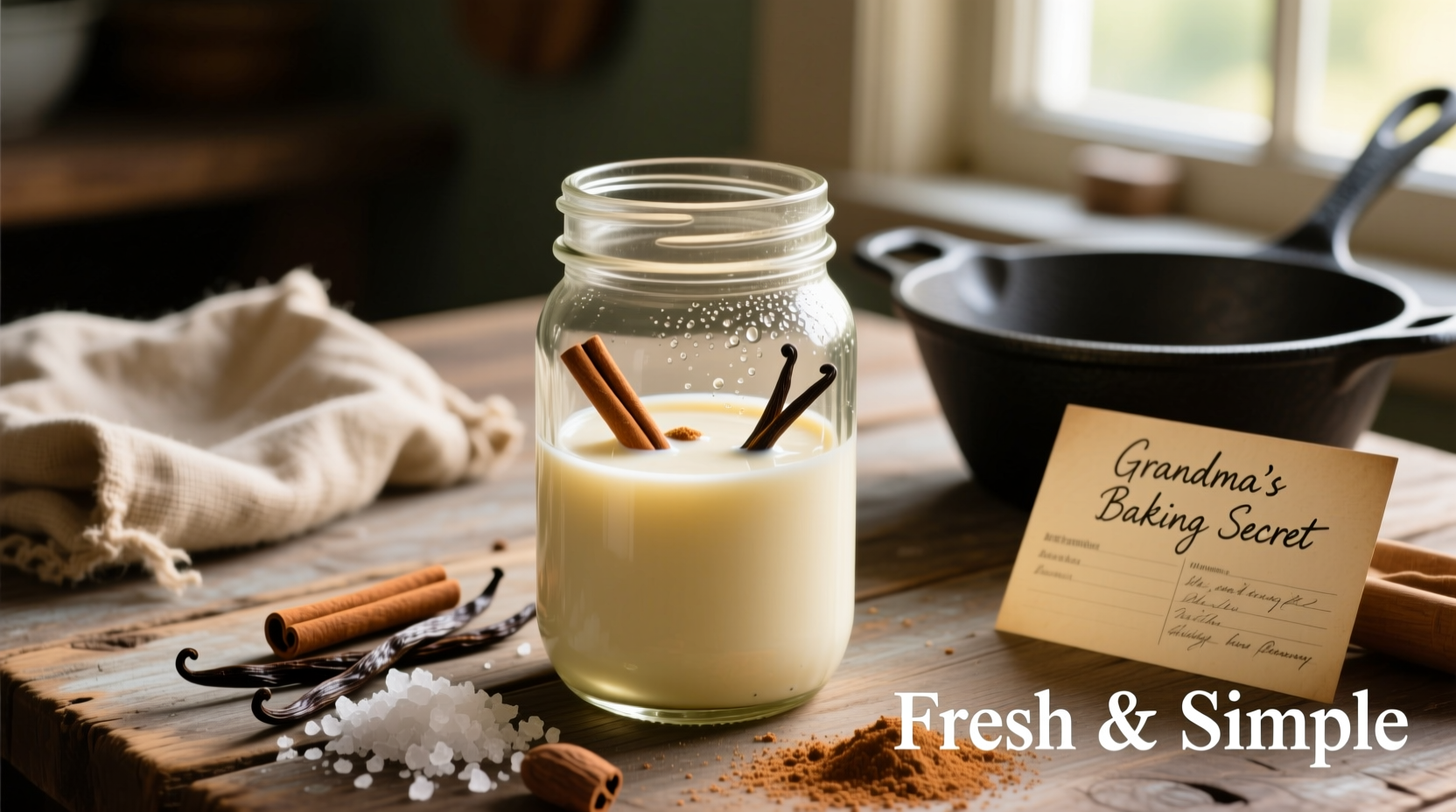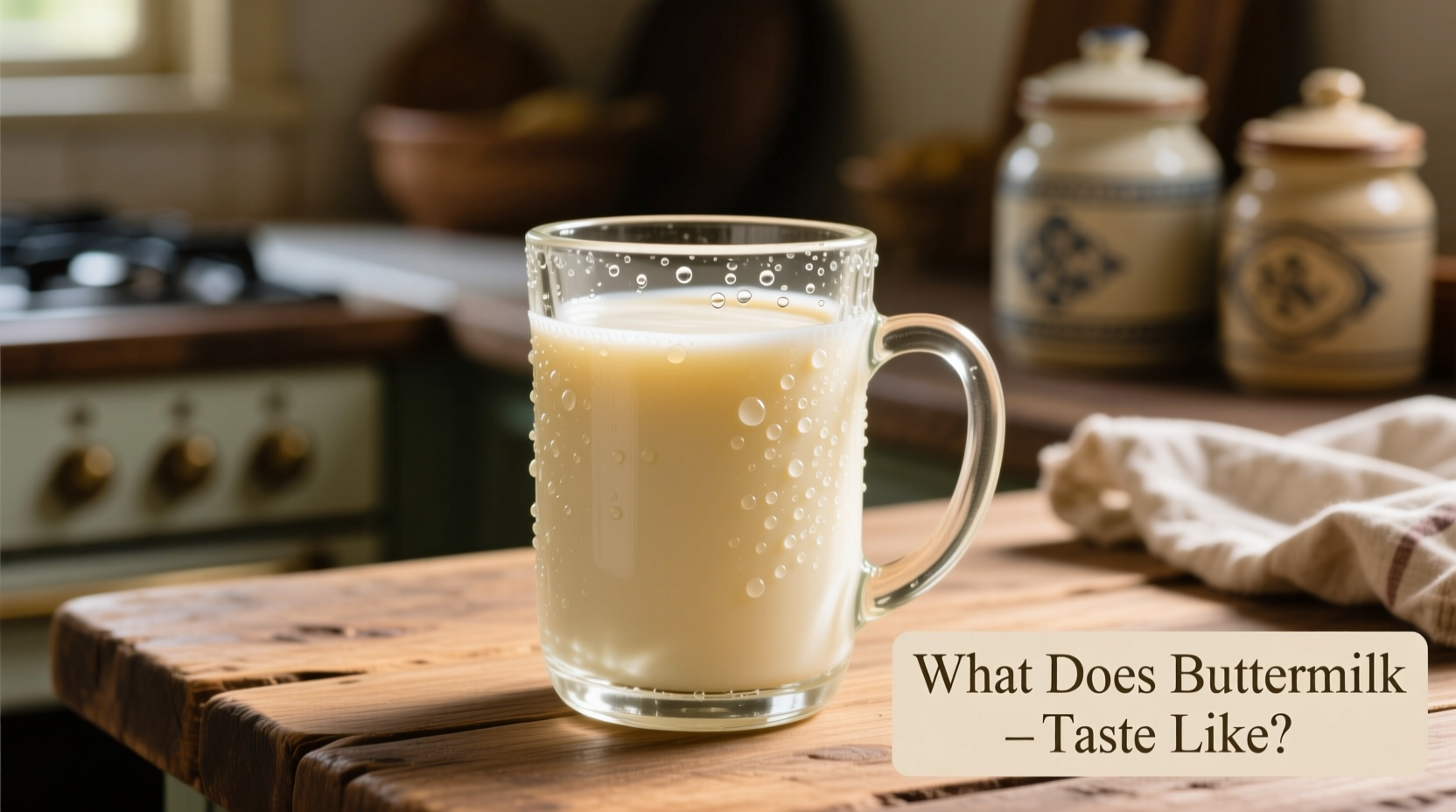Ever wondered what does buttermilk taste like when you see it listed in baking recipes? This dairy staple delivers a unique flavor profile that transforms everything from pancakes to salad dressings. Understanding its distinctive taste helps you leverage buttermilk's magic in your kitchen with confidence.
The Tangy Taste Profile of Buttermilk
When you take your first sip of buttermilk, you'll immediately notice its characteristic tanginess—a pleasant sourness that sets it apart from regular milk. This cultured dairy product offers a complex flavor experience:
- Acidity level: Mildly acidic (pH around 4.4-4.6), creating that signature tang without overwhelming sharpness
- Sweetness: Noticeably less sweet than regular milk due to lactose conversion during fermentation
- Aftertaste: Clean finish with subtle buttery undertones (despite the name, it contains minimal actual butter)
- Mouthfeel: Creamy texture but thinner than yogurt, with a smooth consistency that coats the tongue
According to research from the USDA Agricultural Research Service, the lactic acid bacteria Lactococcus lactis creates buttermilk's distinctive flavor through controlled fermentation, converting milk sugars into lactic acid while developing complex flavor compounds.
Buttermilk vs. Other Dairy Products: A Flavor Comparison
| Dairy Product | Taste Profile | Acidity Level | Best Culinary Uses |
|---|---|---|---|
| Traditional Buttermilk | Tangy, slightly sour, subtle buttery notes | Moderate (pH 4.4-4.6) | Baking, marinades, dressings |
| Regular Milk | Sweet, neutral, mild | Low (pH 6.5-6.7) | Drinking, general cooking |
| Yogurt | Sharp tang, pronounced sourness | High (pH 4.0-4.4) | Parfaits, dips, some baking |
| Sour Cream | Rich tang, fatty mouthfeel | Moderate (pH 4.5) | Dips, toppings, baking |
This buttermilk taste compared to yogurt shows why buttermilk works better in certain recipes—its milder acidity creates tender baked goods without overwhelming sourness. As culinary expert Harold McGee explains in On Food and Cooking, buttermilk's balanced acidity reacts perfectly with baking soda to create light, fluffy textures while adding complex flavor notes.
The Science Behind Buttermilk's Flavor Development
Modern cultured buttermilk—what you'll find in grocery stores today—gets its distinctive taste through a precise fermentation process. Here's how it evolves:
- Initial state: Pasteurized low-fat milk provides the base
- Inoculation: Specific bacterial cultures (Lactococcus lactis and Leuconostoc citrovorum) are added
- Fermentation: 12-14 hours at controlled temperature (68-72°F)
- Flavor development: Bacteria convert lactose to lactic acid while producing diacetyl (buttery flavor) and other compounds
- Final product: Tangy, slightly thickened liquid with pH 4.4-4.6
This controlled process creates buttermilk's signature taste that's why does buttermilk taste tangy yet balanced—never harsh or overpowering. The USDA's Dairy Science program confirms that proper fermentation develops approximately 20 distinct flavor compounds that create buttermilk's complex profile.
How Buttermilk's Flavor Transforms Your Cooking
Understanding how buttermilk flavor affects baking reveals why chefs prize this ingredient. Its unique taste profile serves multiple culinary functions:
- Chemical reaction: The acidity activates baking soda, creating carbon dioxide bubbles for perfect rise
- Flavor enhancement: Tanginess balances sweetness in baked goods, creating more complex flavor profiles
- Texture modification: Acid tenderizes gluten, yielding incredibly tender cakes and biscuits
- Marinade magic: The mild acidity breaks down proteins without making meat mushy
Professional bakers note that substituting regular milk for buttermilk changes both texture and flavor balance. As the America's Test Kitchen research demonstrates, buttermilk creates biscuits with 37% more tenderness and a more complex flavor profile than those made with regular milk.
Practical Tips for Using Buttermilk Based on Its Flavor
Now that you know what does cultured buttermilk taste like, here's how to maximize its potential in your kitchen:
- Shake before using: Buttermilk separates—gently shake the carton to redistribute the cultures
- Temperature matters: Use cold buttermilk for baking to control the baking soda reaction
- Flavor pairing: Complements sweet ingredients (buttermilk pancakes with maple syrup) and savory elements (buttermilk ranch dressing)
- Substitution knowledge: If you need buttermilk and don't have any, add 1 tablespoon vinegar or lemon juice to 1 cup milk and let sit 5 minutes

Remember that buttermilk's flavor works differently in various applications. In salad dressings, its tang cuts through rich ingredients. In baked goods, it creates subtle complexity. In marinades, it tenderizes without overpowering. This versatility explains why professional chefs consider it an essential pantry staple.
Common Misconceptions About Buttermilk's Taste
Several myths persist about buttermilk's flavor profile:
- Myth: Buttermilk tastes strongly of butter Fact: Despite the name, buttermilk contains minimal butterfat and gets its name from traditional production methods
- Myth: Spoiled milk and buttermilk taste the same Fact: Properly cultured buttermilk has a clean, pleasant tang, while spoiled milk has unpleasant sourness and off-flavors
- Myth: All buttermilk tastes identical Fact: Flavor varies slightly by brand based on bacterial strains and fermentation time
When evaluating is buttermilk supposed to taste sour, remember that fresh buttermilk should have a clean, pleasant tang—never sharp, unpleasant, or rancid. If your buttermilk develops off-flavors or mold, it's past its prime (typically good for 7-10 days after opening).
When Buttermilk's Flavor Shines Best
Certain recipes specifically leverage buttermilk's unique taste profile. Understanding these buttermilk taste context boundaries helps you decide when to reach for this ingredient:
- Ideal applications: Biscuits, pancakes, waffles, fried chicken marinades, creamy dressings, certain cakes
- Limited benefit: Recipes already high in acidity (like those with buttermilk substitutes)
- Poor substitution: In recipes requiring neutral-flavored dairy (cream soups, custards)
- Flavor pairing tip: Buttermilk's tang complements baking soda, honey, maple, and warm spices like cinnamon
Food scientists at Cornell University's Food Science Department note that buttermilk's flavor compounds interact uniquely with wheat proteins, creating textures impossible to replicate with milk substitutes. This explains why professional bakers insist on real buttermilk for signature recipes.
Frequently Asked Questions
Does buttermilk taste sour like spoiled milk?
No, properly cultured buttermilk has a clean, pleasant tanginess that's distinctly different from spoiled milk. Spoiled milk develops unpleasant, sharp sourness and off-flavors, while buttermilk's controlled fermentation creates a balanced, mild acidity with subtle buttery notes.
Why does buttermilk taste different from regular milk?
Buttermilk contains live bacterial cultures that ferment the lactose (milk sugar) into lactic acid, creating its characteristic tanginess. Regular milk lacks these cultures and maintains its natural sweetness. The fermentation process also develops additional flavor compounds that give buttermilk its complex profile.
Can I tell if buttermilk has gone bad by taste alone?
While taste can indicate spoilage, you shouldn't rely solely on taste to determine if buttermilk has gone bad. Fresh buttermilk should have a clean, pleasant tang. If it develops a sharp, unpleasant sourness, bitter notes, or any off-flavors, it's spoiled. Always check for visible mold, unusual thickening, or unpleasant odors before tasting.
Does the fat content affect buttermilk's taste?
Yes, fat content influences buttermilk's flavor perception. Low-fat buttermilk (typically 1-2% fat) has a brighter, more pronounced tanginess, while full-fat versions offer a richer mouthfeel that slightly mutes the acidity. However, the fundamental tangy flavor profile remains consistent across fat levels due to the fermentation process.
Why does buttermilk taste better in some recipes than others?
Buttermilk shines in recipes where its acidity can react with baking soda for leavening and where its tang complements other ingredients. It works exceptionally well in biscuits, pancakes, and fried chicken marinades. In recipes requiring neutral dairy flavor (like cream soups), its tanginess might be less desirable. The specific bacterial strains and fermentation time also create subtle flavor variations between brands.











 浙公网安备
33010002000092号
浙公网安备
33010002000092号 浙B2-20120091-4
浙B2-20120091-4